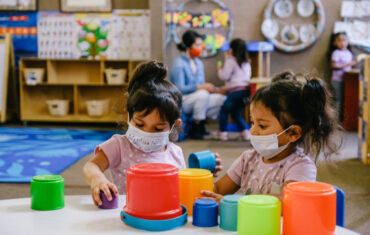While most public pools are not opening this season, there are a few exceptions. And of course, there are always lakes and other natural spots for relief from the heat. Outside of the water, face covers are required unless you can maintain social distancing.
As states begin to reopen pools, many are wondering if it’s safe to head back into the water with face covers. The CDC says a properly maintained pool using chlorine or bromine is safe. But before you grab your suit and do a cannonball, remember a virus-free pool doesn’t mean a risk-free swim season. You could still catch COVID-19 from touching a contaminated surface or with person-to-person contact.
Before You Go
When deciding what’s safe and what’s not for your family this summer. You can check your local, state, and community orders and ask yourself some core COVID-19 questions.
Are you or anyone you live with over age 65 or at risk of severe illness? The risk of getting a serious infection from COVID-19 increases with age and certain medical conditions.
Do you and those you will be interacting with follow the same steps to prevent infection, such as wearing face covers and washing hands?
Will the activity put you in close contact with others? If so, can you maintain 6 feet of social distance in a reasonable way?
Avoid sharing items, but if you have to, are you prepared to clean and disinfect them between each use?
While You’re There
Your pool bag should have plenty of hand sanitizer and separate drink bottles, towels, toys, goggles, and floats or pool noodles for each person. And yes, protective face covers.
Certain face covers, like those used in snorkeling, are made for the water. In fact, some scientists are repurposing snorkeling masks to use as protective gear for health care workers. But cloth masks and swimming don’t mix. The CDC says you should never wear cloth face covers while in the water. A cloth mask becomes heavy when wet, and that makes breathing difficult.
Do wear a face cover when on the pool deck, entering restrooms and other public buildings, or interacting with others when you’re not in the water. You should maintain 6 feet of social distancing in and out of the pool. Not sure how close is too close? Use a pool noodle as a rough guide.
Remember, specific COVID-19 pool rules vary from state to community to neighborhood. Even if a state or local ban is lifted, homeowners’ associations have the authority to keep a pool closed if they feel it can’t be safely operated. To promote safety and reduce the spread of germs, reopened pools have removed all pool furniture or have spaced seating apart to allow for social distancing. Some swimming pools are limiting capacity and require reservations.
After You Leave
While chlorine appears to inactivate the coronavirus, taking a dip in a pool doesn’t take the place of good old-fashioned hand-washing. After leaving the pool, wash your hands with soap and water for 20 seconds, or use hand sanitizers that contains at least 60% alcohol. Clean and disinfect any pool toys, chairs, and other equipment that you brought with you. And use face covers when leaving.






